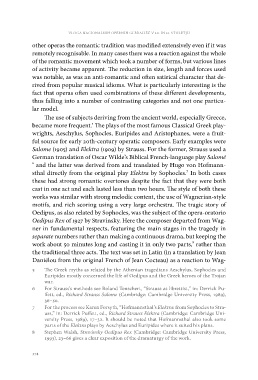Page 376 - Weiss, Jernej, ur. 2019. Vloga nacionalnih opernih gledališč v 20. in 21. stoletju - The Role of National Opera Houses in the 20th and 21st Centuries. Koper/Ljubljana: Založba Univerze na Primorskem in Festival Ljubljana. Studia musicologica Labacensia, 3
P. 376
vloga nacionalnih opernih gledališč v 20. in 21. stoletju
other operas the romantic tradition was modified extensively even if it was
remotely recognisable. In many cases there was a reaction against the whole
of the romantic movement which took a number of forms, but various lines
of activity became apparent. The reduction in size, length and forces used
was notable, as was an anti-romantic and often satirical character that de-
rived from popular musical idioms. What is particularly interesting is the
fact that operas often used combinations of these different developments,
thus falling into a number of contrasting categories and not one particu-
lar model.
The use of subjects deriving from the ancient world, especially Greece,
became more frequent.5 The plays of the most famous Classical Greek play-
wrights, Aeschylus, Sophocles, Euripides and Aristophanes, were a fruit-
ful source for early 20th-century operatic composers. Early examples were
Salome (1905) and Elektra (1909) by Strauss. For the former, Strauss used a
German translation of Oscar Wilde’s Biblical French-language play Salomé
6 and the latter was derived from and translated by Hugo von Hofmann-
sthal directly from the original play Elektra by Sophocles.7 In both cases
these had strong romantic overtones despite the fact that they were both
cast in one act and each lasted less than two hours. The style of both these
works was similar with strong melodic content, the use of Wagnerian-style
motifs, and rich scoring using a very large orchestra. The tragic story of
Oedipus, as also related by Sophocles, was the subject of the opera-oratorio
Oedipus Rex of 1927 by Stravinsky. Here the composer departed from Wag-
ner in fundamental respects, featuring the main stages in the tragedy in
separate numbers rather than making a continuous drama, but keeping the
work about 50 minutes long and casting it in only two parts,8 rather than
the traditional three acts. The text was set in Latin (in a translation by Jean
Daniélou from the original French of Jean Cocteau) as a reaction to Wag-
5 The Greek myths as related by the Athenian tragedians Aeschylus, Sophocles and
Euripides mostly concerned the life of Oedipus and the Greek heroes of the Trojan
war.
6 For Strauss’s methods see Roland Tenschert, “Strauss as librettist,” in: Derrick Pu-
ffett, ed., Richard Strauss Salome (Cambridge: Cambridge University Press, 1989),
36–50.
7 For the process see Karen Forsyth, “Hofmannsthal’s Elektra: from Sophocles to Stra-
uss,” in: Derrick Puffett, ed., Richard Strauss Elektra (Cambridge: Cambridge Uni-
versity Press, 1989), 17–32. It should be noted that Hofmannsthal also took some
parts of the Elektra plays by Aeschylus and Euripides where it suited his plans.
8 Stephen Walsh, Stravinsky Oedipus Rex (Cambridge: Cambridge University Press,
1993), 23–66 gives a clear exposition of the dramaturgy of the work.
374
other operas the romantic tradition was modified extensively even if it was
remotely recognisable. In many cases there was a reaction against the whole
of the romantic movement which took a number of forms, but various lines
of activity became apparent. The reduction in size, length and forces used
was notable, as was an anti-romantic and often satirical character that de-
rived from popular musical idioms. What is particularly interesting is the
fact that operas often used combinations of these different developments,
thus falling into a number of contrasting categories and not one particu-
lar model.
The use of subjects deriving from the ancient world, especially Greece,
became more frequent.5 The plays of the most famous Classical Greek play-
wrights, Aeschylus, Sophocles, Euripides and Aristophanes, were a fruit-
ful source for early 20th-century operatic composers. Early examples were
Salome (1905) and Elektra (1909) by Strauss. For the former, Strauss used a
German translation of Oscar Wilde’s Biblical French-language play Salomé
6 and the latter was derived from and translated by Hugo von Hofmann-
sthal directly from the original play Elektra by Sophocles.7 In both cases
these had strong romantic overtones despite the fact that they were both
cast in one act and each lasted less than two hours. The style of both these
works was similar with strong melodic content, the use of Wagnerian-style
motifs, and rich scoring using a very large orchestra. The tragic story of
Oedipus, as also related by Sophocles, was the subject of the opera-oratorio
Oedipus Rex of 1927 by Stravinsky. Here the composer departed from Wag-
ner in fundamental respects, featuring the main stages in the tragedy in
separate numbers rather than making a continuous drama, but keeping the
work about 50 minutes long and casting it in only two parts,8 rather than
the traditional three acts. The text was set in Latin (in a translation by Jean
Daniélou from the original French of Jean Cocteau) as a reaction to Wag-
5 The Greek myths as related by the Athenian tragedians Aeschylus, Sophocles and
Euripides mostly concerned the life of Oedipus and the Greek heroes of the Trojan
war.
6 For Strauss’s methods see Roland Tenschert, “Strauss as librettist,” in: Derrick Pu-
ffett, ed., Richard Strauss Salome (Cambridge: Cambridge University Press, 1989),
36–50.
7 For the process see Karen Forsyth, “Hofmannsthal’s Elektra: from Sophocles to Stra-
uss,” in: Derrick Puffett, ed., Richard Strauss Elektra (Cambridge: Cambridge Uni-
versity Press, 1989), 17–32. It should be noted that Hofmannsthal also took some
parts of the Elektra plays by Aeschylus and Euripides where it suited his plans.
8 Stephen Walsh, Stravinsky Oedipus Rex (Cambridge: Cambridge University Press,
1993), 23–66 gives a clear exposition of the dramaturgy of the work.
374


